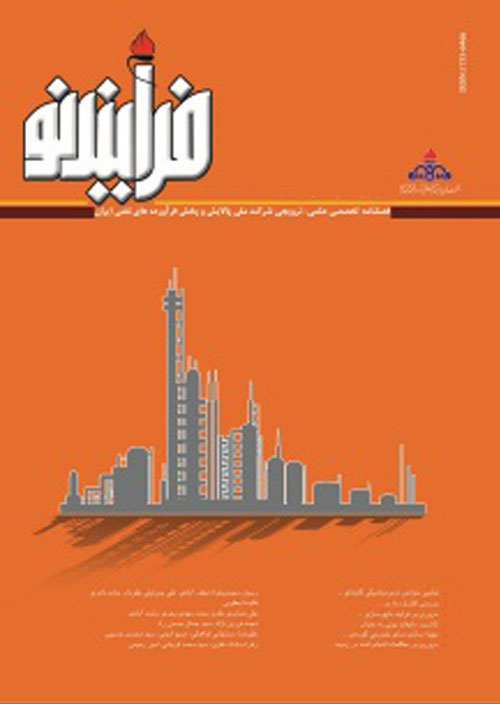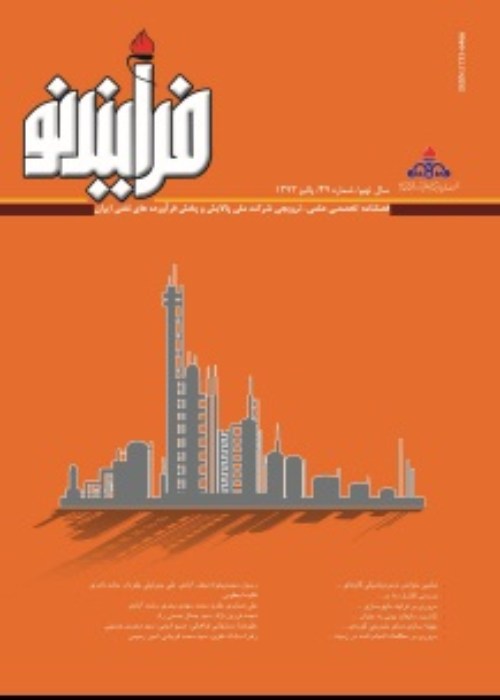فهرست مطالب

مجله فرآیند نو
پیاپی 63 (پاییز 1397)
- تاریخ انتشار: 1397/07/22
- تعداد عناوین: 6
-
-
صفحات 5-42پتنت های تاثیرگذار در توسعه فرآیند ایزومریزاسیون نفتای سبک بصورت فنی به 5 گروه فرآیند، کاتالیست، جداسازی، راکتور و پیش تصفیه دسته بندی شدند. تحلیل آماری پتنت ها نشان داد که بیشترین تعداد پتنت در زمینه فرآیند یا کاتالیست و اکثرا توسط شرکت های UOP و شل ارایه شده اند. در بین پتنت های ثبت شده، پتنت های ارایه شده توسط شرکت UOP پر مراجعه ترین پتنت ها می باشند. همچنین طبق نتایج بدست آمده، سه گروه کاتالیست های آلومینیوم کلراید، زیولیتی و اکسید فلزی مانند پلاتین، پالادیوم و رودیوم روی پایه ی آلومینای کلره استفاده شده است که با توجه به خوراک، شرایط عملیاتی و محصول مورد نظر، کاتالیست بهینه انتخاب می شود. تفاوت اصلی فرآیندهای پیشنهادی در نحوه ی جداسازی نرمال پارافین از ایزوپارافین ها می باشد. برای جداسازی پارافین های شاخه دار از نرمال پارافین ها از روش های غربال مولکولی یا برج های DIH (برج جداکننده ایزوهگزان) و DIP (برج جداکننده ایزوپنتان) در ورودی یا خروجی راکتور استفاده می شود.کلیدواژگان: ایزومریزاسیون، نفتای سبک، هیدروکربن های پارافینی، پنتان و هگزان
-
صفحات 45-59در این مطالعه، نازل های فراصوتی به عنوان یک سیستم فشارقوی متراکم که قادر به جداسازی میعانات گازی از گازطبیعی می باشد، معرفی گردیده است. یکی از مهم ترین مزایای این سیستم، بازیابی فشار تا حد زیادی در ناحیه واگرای نازل، طی پدیده تراکم موج ضربه ای می باشد. از طرفی نازل های فراصوتی فاقد تجهیزات دوار می باشند و بکارگیری آنها نیازی به مصرف انرژی ندارد. برای مدل کردن و شبیه سازی جداکننده های فراصوتی، یک دسته معادلات غیرخطی با استفاده از نرم افزارهای MATLAB و HYSYS به صورت عددی حل شدند. در این پژوهش اثر دما، فشار و دبی جریان خوراک ورودی، فشار برگشتی در خروجی نازل و رفتار جریان در داخل نازل ارزیابی شده است. نتایج کار حاضر نشان داد که جداسازی انتخابی آب و میعانات گازی با افزایش فشارورودی در دمای ثابت، افزایش دمای ورودی در فشار خروجی ثابت و کنترل فشار برگشتی امکان پذیر است.کلیدواژگان: استحصال مایعات هیدروکربوری، شبیه سازی، گاز با رفتار میعان معکوس، موج ضربه ای، نازل فراصوتی
-
صفحات 60-69
ذخیره و نگهداری نفت خام در مخازن پالایشگاه ها سبب می شود با گذشت زمان، مقدار زیادی لجن متراکم و نسبتا جامد در کف مخازن تشکیل شده که حاوی مقادیر زیادی فلزات و هیدروکربن های نفتی هستند که سبب خوردگی کف این مخازن می شوند. این لجن برای محیط زیست بسیار خطرناک هستند و باید پیش از تخلیه به محیط زیست بطور کامل تصفیه شوند. در این مقاله از کنسرسیوم باکتریایی موجود در پساب پالایشگاه کرمانشاه برای تصفیه لجن نفتی ته مخازن استفاده شد. جهت کشت باکتری ها از محیط کشت براث استفاده شد. تاثیر دما، pH، غلظت لجن نفتی، یون فسفات، زمان ماند و رطوبت بر عملکرد فرایند تجزیه مورد بررسی قرار گرفت. نتایج نشان می دهد که میکروارگانیسم ها در pH نزدیک به خنثی (5/7) بیشترین کارایی را دارند و دمای 30 درجه دمای بهینه برای فرایند است. همچنین افزایش یون فسفات و کاهش رطوبت باعث کاهش فرایند حذف هیدروکربن ها می شوند.
کلیدواژگان: کنسرسیوم باکتریایی، مخازن نفت خام، لجن، هیدروکربن های نفتی -
صفحات 70-95
با استفاده از فرآیندهای بهبود یافته (مانند چیدمان های پیشرونده و توزیع شونده) می توان میزان قابل توجهی از مصرف انرژی و آلاینده های تولیدی در فرآیند تقطیر نفت خام را کاهش داد. با این حال فرآیندهای بهبود یافته بصورت عملیاتی مورد آزمایش قرار نگرفته اند. در این پژوهش با درنظر گرفتن هزینه های تحمیل شده به واحد پالایشگاهی به دلیل تولید آلاینده ها و ضایعات زیست محیطی و انرژی مصرفی این فرآیندها نشان داده شده است که فرآیندهای بهبود یافته می توانند به عنوان گزینه مناسبی برای واحدهای نو تاسیس مدنظر قرار گیرند. بررسی نتایج برای نمونه های نفت سبک و سنگین ایران بیانگر صرفه اقتصادی این چیدمان ها و قابلیت استفاده از آن ها به عنوان جایگزینی مناسب برای فرآیند سنتی تقطیر نفت خام در ایران است. درآمد ناخالص حاصل از فروش محصولات در مورد نمونه سبک نفت خام حدود 13/0 میلیون دلار و در مورد نمونه نفت سنگین 13/12 میلیون دلار افزایش را نشان می دهد.
کلیدواژگان: تقطیر نفت خام، چیدمان پیشرونده، چیدمان توزیع شده، کاهش مصرف انرژی -
صفحات 96-110
امروزه هیدروژن و گازسنتز دو ماده اولیه بسیار مهم در صنایع نفت، گاز و پتروشیمی محسوب می شوند که نیاز به این دو ماده به طور چشمگیری روز به روز در حال افزایش است. بنابراین، تلاش برای یافتن فرآیندهای اقتصادی و دوستدار محیط زیست برای تولید این مواد، لازم و ضروری است. از مهمترین روش های تولید گازسنتز گازی کردن زغال سنگ، تبدیل متان با بخارآب، اکسیداسیون جزیی متان، تبدیل اتوترمال متان، تبدیل متان با کربن دی اکسید و فرآیند تری ریفورمینگ متان می باشند. دراین مقاله، تحقیقات انجام شده در زمینه تبدیل متان با کربن دی اکسید و همچنین کوپل این روش با روش های دیگر تولید گازسنتز ارایه شده است. نتایج تحقیقات صورت گرفته نشان می دهد فرآیند تبدیل متان با کربن دی اکسید به دلیل کاهش نشر گازهای گلخانه ای و تولید گاز سنتزی مناسب جهت فرآیندهای پایین دستی، می تواند جایگزین مناسبی برای فرآیندهای حال حاضر مانند تبدیل متان با بخارآب باشد.
کلیدواژگان: گازسنتز، کربن دی اکسید، تبدیل متان با کربن دی اکسید، ریفرمینگ خشک متان، کوپل راکتورها -
صفحات 111-123با توجه به محدودیت دسترسی به لوله کشی واحدهای صنعتی در محل و همچنین با هدف تسریع در نصب لوله ها، عملیات اسپول سازی در قالب فرآیند پیش ساخت صورت می پذیرد. در یک تعریف ساده، اسپول به مجموعه اتصالات و قطعات متصل به آن ها گفته می شود. اولویت بندی ساخت اسپول ها در فرآیند پیش ساخت یکی از مهم ترین مراحل پروژه است. از سوی دیگر، استفاده از مدل های پیچیده تعیین توالی عملیات که اکثرا حجیم و زمان بر هستند نیز حل مسئله را دشوار می نماید. بنابراین، ارایه یک رویکرد تصمیم گیری جهت اولویت بندی ساخت، به جهت افزایش دقت و جامعیت ضروری است. در این مقاله، ضمن بررسی اولویت های مطرح حوزه اسپول سازی، از روش های مجموع وزنی ساده و ارزیابی نسبی پیچیده (COPRAS) به عنوان روش های تصمیم گیری ساده، قابل فهم و سریع در قالب حل مثال عددی صنعتی، استفاده شده است. نتایج حاصل و مقایسه آن ها با مقادیر شهودی تصمیم گیرنده نشان دهنده منطقی و کاربردی بودن آن ها می باشد.کلیدواژگان: لوله کشی صنعتی، اولویت بندی، فرآیند اسپول سازی، مجموع وزنی ساده
-
Pages 5-42The light naphtha isomerization patents were technically categorized into 5 groups of process, catalyst, isolation, reactor and pre-treatment. The largest number of patents is in the process and catalyst fields mainly filed by UOP and Shell companies. The highest number of patents were registered in the 1960s. The patents published by UOP are the most widely cited. Largest number of patents are filed in the United States which reveals that US is the main target market for isomerization process. Three groups of aluminum chloride, zeolite and metal oxide catalysts such as platinum, palladium and rhodium have been used on chlorine alumina support, which is chosen as the optimal catalyst according to the feed, operating conditions and product. There are two main separation techniques for fractionation of normal paraffin from isoparaffin; namely, molecular sieve towers or DIH towers (Deisohexanizer) and DIP (Deisopentanizer) which are placed before or after the reactor.Keywords: Isomerization, light naphtha, paraffinic hydrocarbons, pentane, Hexane
-
Pages 45-59In this study, supersonic nozzle is introduced as a high pressure system capable of separating condensate gas from natural gas. One of the most important advantages of this system is that the pressure recovery is largely in the divergent region of the nozzle during the shock wave phenomenon. On the other hand, the supersonic nozzle do not have rotating equipment and their use does not require energy. For modeling of supersonic separators, a series of nonlinear equations were solved numerically using MATLAB and HYSYS software. In this investigation, the effect of temperature, pressure and flow rate of feed inlet, return pressure on nozzle output and flow behavior inside nozzle are evaluated. The results of present work show that the selective separation of water and gas condensates by increasing the inlet pressure at constant temperature, increasing the inlet temperature at a constant outlet pressure and controlling the return pressure is feasible.Keywords: Extraction of hydrocarbon liquids, Gas with reverse condensation behaviour, Simulation, Shock wave, Supersonic nozzle
-
Pages 60-69
Residual oil in the storage tanks usually lead to accumulation of oily sludge which should be treated and disposed in a suitable manner. In this paper, the bacterial consortium of oil sludge in Kermanshah plant wastewater was used for treatment of oily slug in storage tanks. Broth culture was used for culturing bacteria. In this work, effect of many parameters on degradation process was investigated such as temperature, pH, oily slug content, phosphate ion, residence time and humidity. Results show that the maximum of microorganisms efficiency was in pH of 7.5 and the temperature of 30oC. Removal of hydrocarbons was decreased in both increase of phosphate ion and decrease of humidity. Also the results indicated that the use of microorganisms in the refinery wastewater treatment of oily sludge in storage tank was an efficient, inexpensive method, and also reduced hydrocarbons to acceptable levels.
Keywords: Bacterial Consortium, Oil storage tanks, Sludge, Hydrocarbons -
Pages 70-95
By applying new processes (Progressive or Distributed Sequences) in Crude Oil distillation process a significant amount of energy consumption and environmental effluents could be reduced. Although, the new processes are not operational and tested in real industries, but their economic and environmental performance was confirmed by different researchers. In this work by considering imposing prices of environmental effluents and energy consumptions, it is illustrated that, the new processes could be a good replacement for conventional process in new established refineries. The analysis of these new configurations for a light and heavy oil sample of Iran, illustrate that the progressive and distributed distillation sequences could be a suitable replacement for traditional crude oil distillation systems in Iran. The gross profit of the products of new processes are 0.13 and 12.13 MM$/year more than conventional process for light and heavy oil respectively.
Keywords: Crude Oil Distillation, Progressive Distillation, Distributed Distillation, Energy consumption reduction -
Pages 96-110
In the recent years, hydrogen and synthesis gas are major raw materials for petroleum, gas and petrochemical industries. Demands for these gases all days are increased. By considering consuming of hydrogen and synthesis gas in different industries, it is mandatory to investigate economic and environmental-friendly process for producing thesis gases. Various methods for production of synthesis gas are: coal gasification, steam reforming of methane, partial oxidation of methane, auto thermal reforming of methane, dry reforming of methane and tri-reforming of methane. In this work, several researches about dry reforming of methane plus coupling of several methods have been introduced. Investigated results indicate that dry reforming of methane produces synthesis gases for downstream process by reduction of green house gases emission to environment can be good alternative of currently process.
Keywords: Synthesis gas, Carbon dioxide, Dry reforming of methane, Coupled Reactors -
Pages 111-123With considering the accessibility limitation of industrial units piping and with the aim of accelerating pipes installation, spool pre-fabrication perform a process. As a simple definition, the spool is a complex of parts and the related joints. Spools priorities determination in the piping process is one of the most important stages of the project. On the other hand, using the complicated sequencing models, since their effortful and time-consuming nature, make solving the problem so difficult. Therefore, providing a decision-making approach to increase accuracy and comprehensiveness is necessary. In this paper, we used the simple weighted sum and complex proportional assessment method as the simple, understandable and fast decision-making methods in the industrial numerical example and, By the way, we reviewed and introduced the important priorities in spool pre-fabrication. Finally, the obtained results and the related comparisons with the intuitive values represent reasonability and practicality.Keywords: Industrial piping, Prioritizing, Spool fabrication process, Weighted sum method


